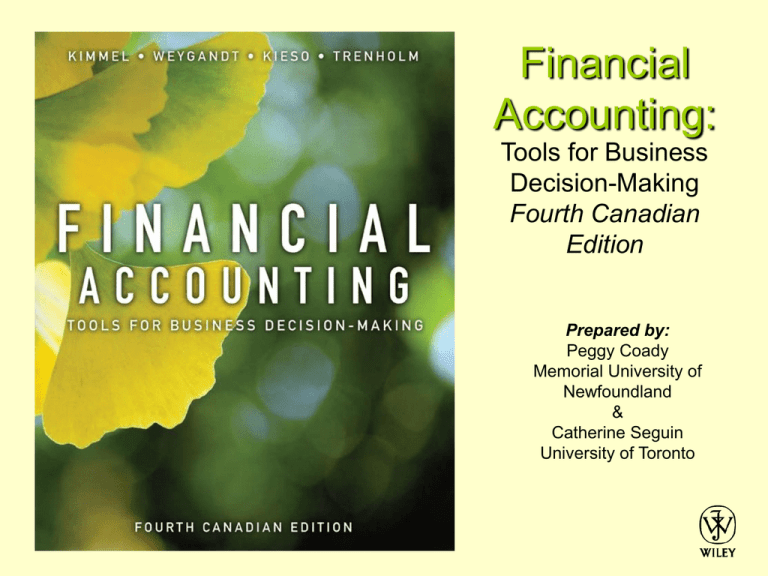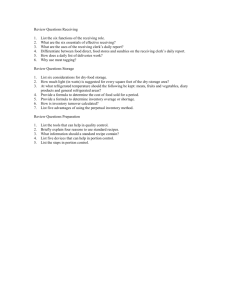
Financial
Accounting:
Tools for Business
Decision-Making
Fourth Canadian
Edition
Prepared by:
Peggy Coady
Memorial University of
Newfoundland
&
Catherine Seguin
University of Toronto
Chapter 6
Reporting and Analyzing
Inventory
Determining Physical
Inventory
• Whether companies use a
periodic or perpetual system,
physical inventory must still be
counted at the end of the period
• This will identify inventory
shrinkage due to theft, spoilage
etc.
Chapter 6
3
Determining Physical
Inventory
• Internal control
– Related methods and measures
to help a company achieve
reliable financial reporting,
effective and efficient operations,
and compliance with relevant
laws and operations
– Especially important for inventory
(Ch. 6) and cash (Ch. 7)
Chapter 6
4
Determining Physical
Inventory
• To ensure inventory is properly
counted companies must have
good internal control
procedures (e.g. prenumbered
tags, counting in teams by
employees that do not have
responsibility for the record
keeping or custody of inventory)
Chapter 6
5
Determining Ownership
• Goods in transit at the end of
the period make determining
ownership more difficult
• Apply the FOB concepts from
Chapter 5
– FOB shipping point
– FOB destination
Chapter 6
6
Determining Ownership
• The ownership of consigned
goods remains with the owner
not the holder of the goods
• Goods taken home “on
approval” by the customer are
still owned by the company
Chapter 6
7
Inventory Cost
Determination Methods
• Specific identification
• Cost formulas
– First-in, first-out (FIFO)
– Average
Chapter 6
8
Specific Identification
• Tracks actual physical flow of goods
• Can only be used when actual costs
of each inventory item can be
determined; where goods are easily
distinguishable (not
interchangeable), or for goods
produced and segregated for
specific projects
• Used in perpetual inventory system
only
Chapter 6
9
Discussion Question
What are some examples of
companies that might use the
specific identification method?
Chapter 6
10
Cost Formulas
• FIFO or Average
• Order or flow of costs assumed
• Can be used in either perpetual
or periodic inventory systems
Chapter 6
11
Perpetual vs Periodic Inventory
Systems
Illustration 6-2
Chapter 6
12
First-in, First-out (FIFO)
• Assumes that the first item
purchased is the first item sold
• Inventory is recorded at most
recent (current) cost. Cost of
goods sold is recorded at the
oldest inventory cost
Chapter 6
13
First-in, First-out (FIFO)
• Ending inventory and cost of
goods sold under FIFO is the
same for perpetual and periodic
inventory systems
Chapter 6
14
Perpetual System Inventory
Costing: FIFO
Illustration 6-6
Chapter 6
15
Average
• Under a perpetual inventory
system, a new weighted
average is calculated after each
purchase and used to record
cost of goods sold and ending
inventory
• Often called moving average in
a perpetual inventory system
Chapter 6
16
Average
• Ending inventory and cost of
goods sold under Average is
usually different for perpetual
and periodic inventory systems
Chapter 6
17
Perpetual System Inventory
Costing: Average
Illustration 6-8
Chapter 6
18
Discussion Question
Why is the average cost formula
called a “moving average cost
formula” in a perpetual inventory
system?
Chapter 6
19
Choice of Cost
Determination Method
• Choose a method that best
– Represents physical flow of
goods
– Reports ending inventory at
recent cost
• Use the same method for
inventories of similar nature and
usage in company
Chapter 6
20
Comparison of Cost
Determination Methods
Illustration 6-10
Chapter 6
21
Summary of Financial
Statement Effects
Illustration 6-11
Chapter 6
22
Inventory Errors
• Errors can occur in accounting
for inventory
• When errors occur they affect
both the statement of earnings
and the balance sheet
• An error in ending inventory can
affect the calculation of cost of
goods sold and net earnings in
two periods
Chapter 6
23
Effects of Inventory Errors on
Current Year’s Statement of
Earnings
Inv e nto ry Erro r
Be g inning Inv e nto ry
U nd e rs ta te
Ov e rs ta te
End ing Inv e nto ry
U nd e rs ta te
Ov e rs ta te
Co s t o f Go o d s So ld
N e t Ea rning s
U nd e rs ta te
Ov e rs ta te
Ov e rs ta te
U nd e rs ta te
Ov e rs ta te
U nd e rs ta te
U nd e rs ta te
Ov e rs ta te
An error in ending inventory of the current period will have
a reverse effect on net earnings of the next accounting
period.
Chapter 6
24
Ending Inventory Error –
Balance Sheet Effect
The effect of ending inventory errors on the balance
sheet can be determined by using the basic
accounting equation:
End ing Inv e nto ry
Erro r
As s e ts
-
Lia b ilitie s
= Sha re ho ld e rs ' Eq uity
U nd e rs ta te
Ov e rs ta te
U nd e rs ta te
Ov e rs ta te
-
N o Effe c t
N o Effe c t
=
=
Chapter 6
U nd e rs ta te
Ov e rs ta te
25
Lower of Cost and Net
Realizable Value (LCNRV)
• When the value of the inventory
declines below net realizable
value, it is written down to its
net realizable value
• Net realizable value (NRV) is
the selling price less any costs
necessary to make the goods
ready for sale
• Departure from cost principle
Chapter 6
26
Lower of Cost and Net
Realizable Value (LCNRV)
• Choose LCNRV item by item
• Allowance method
– Debit write down to Cost of
Goods Sold; Credit to Allowance
to Reduce Inventory to NRV
– Allows reversal if NRV increases
in certain circumstances
Chapter 6
27
Discussion Question
Under what circumstances can a
write-down in inventory to net
realizable value be reversed?
Chapter 6
28
Reporting Inventory
• In the financial statements or
notes the following should be
disclosed for inventory:
–
–
–
–
–
Chapter 6
Total cost of inventory
Cost of goods sold
Method of cost determination
Basis of valuation
Amounts of any write-downs or
reversals
29
How Much Inventory
Should a Company
Have?
• Only enough for sales needs
• Excess inventory costs
– Storage costs
– Interest costs
– Obsolescence
Chapter 6
30
Inventory Turnover
Inventory Turnover
Chapter 6
=
Cost of Goods Sold
Average Inventory
31
Days in Inventory
Days in Inventory
Chapter 6
=
365 Days
Inventory Turnover
32
Appendix 6A
Reminder: Perpetual vs Periodic
Inventory Systems
Illustration 6-2
Chapter 6
33
Appendix 6A
Periodic Inventory System
Illustration 6A-2: FIFO
Chapter 6
34
Appendix 6A
Periodic Inventory System
Illustration 6A-4: Average
Chapter 6
35
Copyright Notice
Copyright © 2009 John Wiley & Sons Canada, Ltd. All rights
reserved. Reproduction or translation of this work beyond that
permitted by Access Copyright (The Canadian Copyright Licensing
Agency) is unlawful. Requests for further information should be
addressed to the Permissions Department, John Wiley & Sons
Canada, Ltd. The purchaser may make back-up copies for his or her
own use only and not for distribution or resale. The author and the
publisher assume no responsibility for errors, omissions, or
damages caused by the use of these programs or from the use of
the information contained herein.






